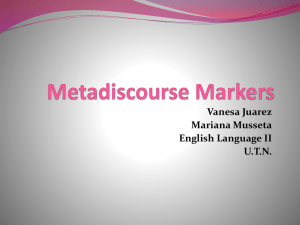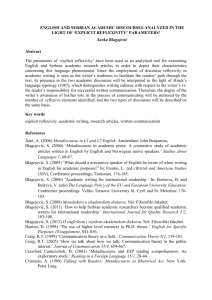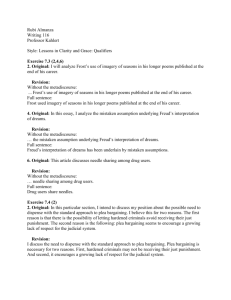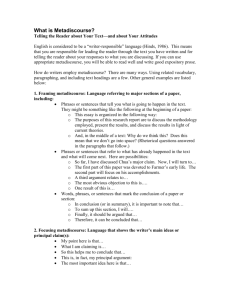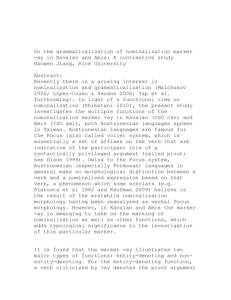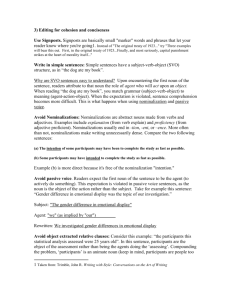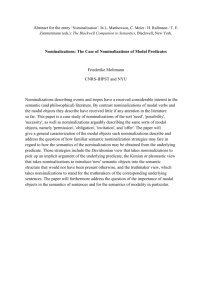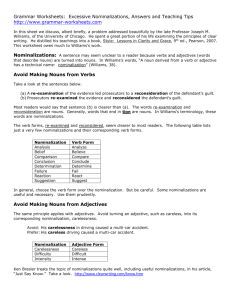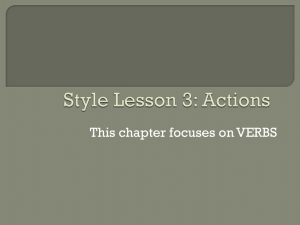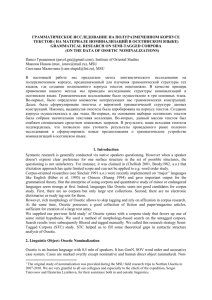Style: Clarity – working with Metadiscourse & Nominalizations
advertisement
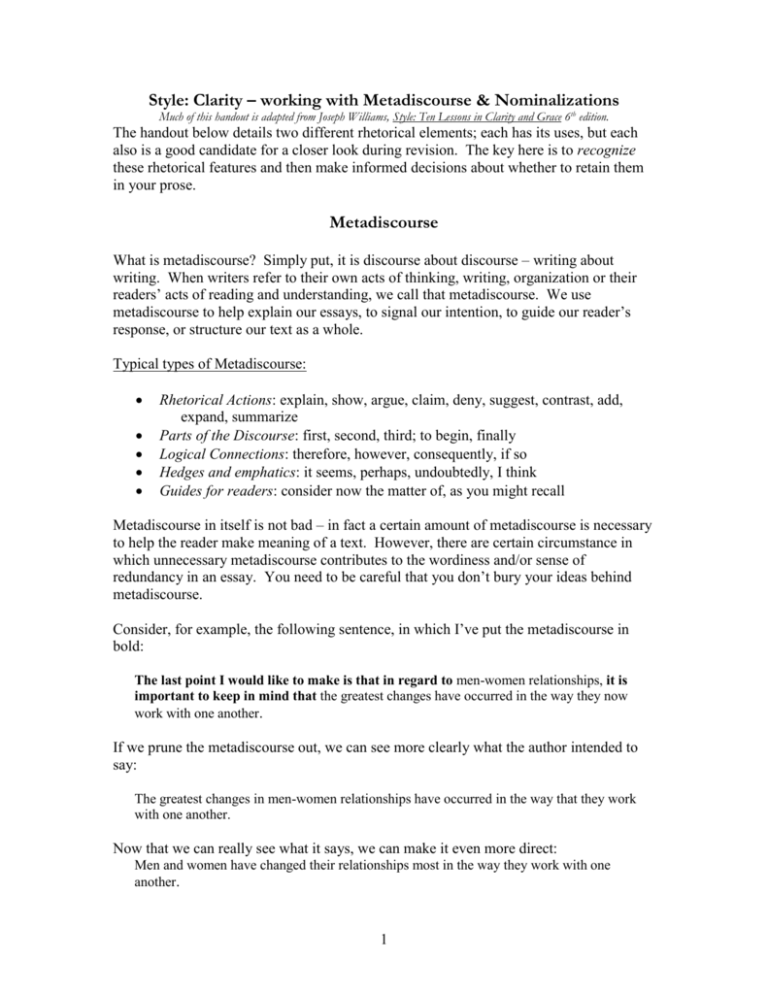
Style: Clarity – working with Metadiscourse & Nominalizations Much of this handout is adapted from Joseph Williams, Style: Ten Lessons in Clarity and Grace 6th edition. The handout below details two different rhetorical elements; each has its uses, but each also is a good candidate for a closer look during revision. The key here is to recognize these rhetorical features and then make informed decisions about whether to retain them in your prose. Metadiscourse What is metadiscourse? Simply put, it is discourse about discourse – writing about writing. When writers refer to their own acts of thinking, writing, organization or their readers’ acts of reading and understanding, we call that metadiscourse. We use metadiscourse to help explain our essays, to signal our intention, to guide our reader’s response, or structure our text as a whole. Typical types of Metadiscourse: Rhetorical Actions: explain, show, argue, claim, deny, suggest, contrast, add, expand, summarize Parts of the Discourse: first, second, third; to begin, finally Logical Connections: therefore, however, consequently, if so Hedges and emphatics: it seems, perhaps, undoubtedly, I think Guides for readers: consider now the matter of, as you might recall Metadiscourse in itself is not bad – in fact a certain amount of metadiscourse is necessary to help the reader make meaning of a text. However, there are certain circumstance in which unnecessary metadiscourse contributes to the wordiness and/or sense of redundancy in an essay. You need to be careful that you don’t bury your ideas behind metadiscourse. Consider, for example, the following sentence, in which I’ve put the metadiscourse in bold: The last point I would like to make is that in regard to men-women relationships, it is important to keep in mind that the greatest changes have occurred in the way they now work with one another. If we prune the metadiscourse out, we can see more clearly what the author intended to say: The greatest changes in men-women relationships have occurred in the way that they work with one another. Now that we can really see what it says, we can make it even more direct: Men and women have changed their relationships most in the way they work with one another. 1 Keeping in mind that you don’t need to eliminate all metadiscourse, here are some types that you probably will want to cut from your writing: 1. Metadiscourse that attributes your ideas to a source. You might announce that something has been anonymously observed or found to exist, or seen, noticed, noted, etc., but it is more direct just to state the fact. Before: High divorce rates have been observed to occur in areas that have been determined to have low population density. After: High divorce rates occur in areas with low population density. 2. Metadiscourse that announces your topic. It is understandable to want to tell your reader what your sentence is “about”, but don’t bury the information in metadiscourse. Before: This section introduces another problem, that of noise pollution. The First thing to say about it is that noise pollution exists not only … After: Another problem is noise pollution. First, it exists not only … 3. Hedging and Intensifying. This type of metadiscourse influences what the readers think about your character – it signals your confidence, your certainty, your caution. This is where you tread the line between timidity and arrogance: keep your audience (and your goals) in mind when making decisions of this nature. Hedges make us sound timid. For instance: Timid: How successfully we tread the rhetorical line between timidity and arrogance often seems to depend at least to some degree on how we manage certain phrases like a good deal. More moderate: How successfully we tread the rhetorical line between timidity and arrogance depends on how we manage phrases like a good deal. Consider, for instance, the following paragraph written by Watson & Crick, announcing one of the most significant breakthroughs in the history of genetics: We wish to suggest a [note: not “the”] structure for the salt of deoxyribose nucleic acid (D.N.A.) . . . . A structure for nucleic acid has already been proposed by Pauling and Corey. . . . In our opinion, this structure is unsatisfactory for two reasons: (1) We believe that the material which gives the X-ray diagrams is the salt, not the free acid. . . . (2) Some of the van der Waals distances appear to be too small. Now consider the same paragraph without the hedges: We announce here the structure for the salt of deoxyribose nucleic acid (D.N.A.) . . . . A structure for nucleic acid has already been proposed by Pauling and Corey. . . . Their structure is unsatisfactory for two reasons: (1) the material which gives their X-ray diagrams is the salt, not the free acid. . . . (2) Their van der Waals distances are too small. 2 What are the different messages that these two paragraphs send their readers? Some typical hedges are: Adverbs: usually, often, sometimes, almost, virtually, possibly, perhaps, apparently, in some ways, to a certain extent, somewhat, in some/certain respects Adjectives: most, many, some, a certain number of Verbs: may, might, can, could, seem, appear, suggest, indicate Intensifiers, as opposed to hedges, make writing more aggressive – sometimes even smug. Intense: For a century now, all liberals have argued against any censorship of art, and every court has found their arguments so completely persuasive that not a person any longer remembers how they were countered. As a result, today, censorship is totally a thing of the past … More moderate: For about a century now, many liberals have argued against censorship of art, and most courts have found their arguments persuasive enough that few people may remember exactly how they were countered. As a result, today, censorship is virtually a thing of the past… Some typical intensifiers are: Adverbs: very, pretty, quite, rather, clearly, obviously, undoubtedly, certainly, of course, indeed, inevitability, invariably, always, literally Adjectives: key, central, crucial, basic, fundamental, major, principal, essential Verbs: show, prove establish, as everyone knows/can see, it is clear/obvious Remember, the goal is not to get rid of all metadiscourse, but to use it occasionally and appropriately in an informed way. Nominalizations What is a “nominalization”? Actually, “nominalization” is a nominalization – that is, a noun derived from a verb or adjective. Here are some examples of how words become nominalized Resist React Careless Verb Nominalization Nominalize nominalization Discover discovery 3 resistance reaction carelessness Different Proficient Sing Result Repair difference proficiency Singing Result Repair Adjective Careless Different Proficient Nominalization carelessness difference proficiency As you may notice, in some cases a verb and its nominalization are identical. A variation on the nominalization is something we might call “adjectivization” – embedding action within an adjective. Such adjectives often appear after the verb “to be”: Verb Apply Fear Hope Indicate Doubt Adjective applicable fearful of hopeful Indicative Dubious Often, nominalizations (and “adjectivizations”) reduce the clarity of a sentence because they produce wordiness and, more importantly, embed action in a noun instead letting the action of a sentence reside in the verb. Since most readers find sentences most clear when they have the subject as the “doer” or agent of action and the verb as conveying the sense of action itself, heavy of use of nominalizations can impede clarity. Consider these examples: Little Red Riding Hood’s suggestion was that the woodchopper complete the killing of the wolf with quickness. Little Red Riding Hood suggested that woodchopper quickly kill the wolf. A revision of the program will result in increases in efficiency in servicing clients. If we revise the problem, we can serve clients more efficiently. The agency conducted an investigation into the matter. The agency investigated the matter. There is no need for further revision of these essays. Students need not revise these essays further. Notice how in each case, the second sentence is much more clear and direct than the first. However, not all nominalizations need to be revised out of your prose. There are some other compelling cases in which you should retain nominalizations in your sentences. 1. Keep a nominalization if revising it out of your prose makes your sentence less clear – more awkward – than keeping it. 4 2. Keep a nominalization if revising it out of your prose makes your writing sound simplistic. An occasional nominalization can make your writing sound more sophisticated (yet, don’t mistake using nominalizations for writing sophisticated prose!). 3. Keep a nominalization if it is a grammatical subject that refers to a previous sentence – i.e. if it is therefore important for enabling the flow of your writing. Examples: This decision was significant for many reasons. These revisions changed the underlying tone of your essay. 4. Keep a nominalization if you are using it instead of saying “The fact that” (which can be very awkward. Examples: The fact that she acknowledged her tendency to overindulge in chocolate impressed me. Her acknowledgement that she tended to overindulge in chocolate impressed me. 5. Keep a nominalization if you are using it to name something that is the object of the verb. Examples: I rejected what she suggested. I rejected her suggestion. 6. Keep a nominalization if it is at the end of the first sentence of a paragraph, especially after a there is/are construction: in this case it can be used to introduce a topic that can be developed in the sentences that follow. Example: There is no need, then, for argument about the existence, the inevitability, and the desirability of change [in language]. There is need, however, for argument about the existence of such a thing as good English and correct English. Let us not hesitate to assert that “The pencil was laying on the table” and “He don’t know nothing” are at present incorrect no matter how many know-nothings say them. 7. Keep a nominalization if it describes a concept so familiar that it is almost a character in itself. I.e.: the First Amendment; the American Revolution; evolution; taxation without representation. 5
